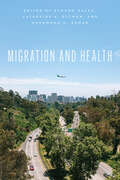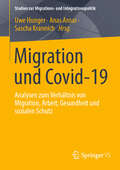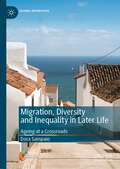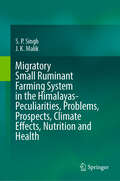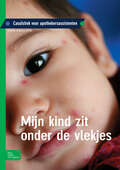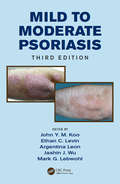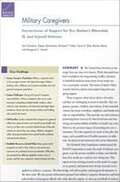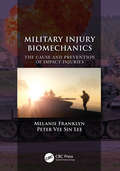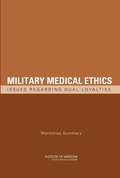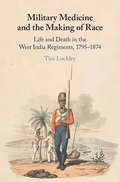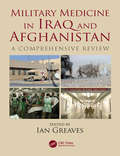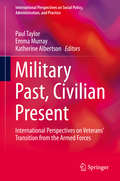- Table View
- List View
Migration and Health
by Sandro Galea Muhammad H. Zaman Catherine K. EttmanA new introduction to a timeless dynamic: how the movement of humans affects health everywhere. International migrants compose more than three percent of the world’s population, and internal migrants—those migrating within countries—are more than triple that number. Population migration has long been, and remains today, one of the central demographic shifts shaping the world around us. The world’s history—and its health—is shaped and colored by stories of migration patterns, the policies and political events that drive these movements, and narratives of individual migrants. Migration and Health offers the most expansive framework to date for understanding and reckoning with human migration’s implications for public health and its determinants. It interrogates this complex relationship by considering not only the welfare of migrants, but also that of the source, destination, and ensuing-generation populations. The result is an elevated, interdisciplinary resource for understanding what is known—and the considerable territory of what is not known—at an intersection that promises to grow in importance and influence as the century unfolds.
Migration and Health
by Sandro Galea Muhammad H. Zaman Catherine K. EttmanA new introduction to a timeless dynamic: how the movement of humans affects health everywhere. International migrants compose more than three percent of the world’s population, and internal migrants—those migrating within countries—are more than triple that number. Population migration has long been, and remains today, one of the central demographic shifts shaping the world around us. The world’s history—and its health—is shaped and colored by stories of migration patterns, the policies and political events that drive these movements, and narratives of individual migrants. Migration and Health offers the most expansive framework to date for understanding and reckoning with human migration’s implications for public health and its determinants. It interrogates this complex relationship by considering not only the welfare of migrants, but also that of the source, destination, and ensuing-generation populations. The result is an elevated, interdisciplinary resource for understanding what is known—and the considerable territory of what is not known—at an intersection that promises to grow in importance and influence as the century unfolds.
Migration and Health: Challenging the Borders of Belonging, Care, and Policy (Studies of the Biosocial Society #10)
by Nadia El-Shaarawi and Stéphanie LarchanchéDespite the centrality of migration in our contemporary world, scholarship on mobility and health frequently separates migrants according to legal status, country of origin, destination, or health concern. Yet people on the move and health systems face challenges and opportunities that transcend these boundaries, including border fortification, neoliberal agendas, and climate change. This volume explores these epistemic borders, recognizing the necessity of a new conversation about migration and health. Each of the empirically grounded chapters introduces readers to pressing questions of migration and health in diverse social, political, and geographical settings.
Migration in der Pflege: Wie Diversität und Individualisierung die Pflege verändern
by Marco Bonacker Gunter GeigerIn einer sich stetig wandelnden (Migrations-)Gesellschaft kommen immer mehr Menschen mit unterschiedlichen kulturellen Prägungen in ein Alter, in dem Pflege notwendig wird. Diversität und Migration prägen ebenso das Feld der Pflegenden. Die steigende Diversität in Pflegesituationen verändert Theorie und Praxis der Pflege. Wie wirkt sich das in Deutschland insgesamt aus? Was müssen Pflegende und Angehörige, was müssen Pflegeinstitutionen nun verstärkt beachten? Inwiefern können wir kultursensible Pflege heute verstehen? Diesen Fragen gehen in diesem Buch Pflege- und Sozialwissenschaftler sowie Praktiker aus der Pflege systematisch und wissenschaftlich fundiert nach.
Migration und Covid-19: Analysen zum Verhältnis von Migration, Arbeit, Gesundheit und sozialen Schutz (Studien zur Migrations- und Integrationspolitik)
by Uwe Hunger Sascha Krannich Anas AnsarDer Band lädt dazu ein, Entwicklungen rund um die Themen Migration, Arbeit, Gesundheit und sozialer Schutz vor dem Hintergrund der COVID-19-Pandemie neu zu überdenken. In den Beiträgen wird deutlich, wie die Pandemie grundsätzliche Probleme der Migration, wie die plötzliche Schließung von Grenzen, schlechte Arbeitsbedingungen und willkürliche Entlassungen von Wanderarbeiter*innen sowie Benachteiligungen bei sozialen Dienstleistungen, wie unter einen Brennglas vergrößert und ihre Dringlichkeit deutlich gemacht hat. Mit dem Abschwächen der Pandemie sind sie damit keineswegs verschwunden, sondern allenfalls wieder aus dem Blickpunkt der öffentlichen Debatten verschwunden. Der Band zeigt auf, wo die Probleme liegen, wo hierfür die Verantwortlichkeiten liegen und wie eine für alle Seiten gewinnbringende Zusammenarbeit von Staaten und anderen Beteiligten möglich ist, um Missstände zu beheben und eine für alle vorteilhafte Migration zu ermöglichen.
Migration, Diversity and Inequality in Later Life: Ageing at a Crossroads (Global Diversities)
by Dora SampaioThis book is the first comprehensive ethnographic study of the diversity of living and ageing experiences of three groups of older migrants – return, lifestyle and ageing-in-place labour migrants – from a comparative perspective. It explores the motivations, ageing experiences and aspirations of transnational ageing migrants in the context of the Portuguese islands of the Azores and situates the research within debates of the ageing-migration nexus. The book’s interdisciplinary approach to transnational embodied and emplaced experiences of ageing facilitates a dialogue between various fields concerned with ageing and mobilities, including geography, anthropology, sociology, social gerontology, social work, and studies of health and wellbeing.
Migration, Health and Ethnicity in the Modern World
by Catherine Cox Hilary MarlandThe volume focuses on the relationship between migration, health and illness in a global context from c. 1820 to the present day. It takes a wide range of finely-grained case studies to examine epidemic disease and its containment, chronic illness and mental breakdown and the health management of migrant populations in the modern world.
Migration, Social Capital, and Health: Insights from Ghana and Uganda (Global Perspectives on Health Geography)
by Raymond Asare Tutu Janice Desire BusingyeThis book brings readers the first scientific publication, using a mixed-method approach, on the internal migration dynamics regarding disease ecologies of informality and the interactions between social capital, lifestyles, health literacy, and health outcomes in the context of informal settlements in two developing countries - Ghana and Uganda. Through the prism of the concepts of place and scale, the book demonstrates the myriad of ways by which place or context directly and indirectly influence migrant's health knowledge, literacy, and outcomes in poor urban slums. Readers will learn about the multi-faceted linkages between social capital, acculturation, and health in places of deprivation via quantitative methods (e.g. surveys) and qualitative methods such as focus group discussions, in-depth interviews, concept mapping, and body health mapping. Chapters 1-2 provide an overview of internal migration into urban slums of Ghana and Uganda, and discuss the intersections between migration, social capital, and health in a global context. Chapters 3-7 address disease patterns, environmental risks to health, health literacy of migrants, social capital and acculturation, and social capital and health. The book will be of interest to professors and students, as well as policy makers in low to middle income countries for planning targeted interventions.
Migratory Small Ruminant Farming System in the Himalayas-Peculiarities, Problems, Prospects, Climate Effects, Nutrition and Health
by S. P. Singh J. K. MalikThis book highlights the animal rearing system that follows a seasonal migratory cycle and in which the animals are reared in the alpine pastures during summer and are returned to the base camps at lower hills with the onset of winter. The initial chapter presents the unique features of the prevailing animal farming system in the hills, and aims at providing a brief overview of the history of pastoralism. The book also describes how the pastoral system has served livelihood of people living in high mountains, the peculiarity and features of this system in different countries, place of ruminants in hill agriculture, historical aspects of pastoralism and tribes, practice of shepherding, grazing rights of herders, current status of migratory livestock system, problems and constraints and strategies for their amelioration. The chapters also provide information on principal minerals limiting small ruminant production, causes of salt hunger in migratory animals grazing at alpine pastures, nutritional status of common pastures and feeds, variation of grass mineral profile and crude protein content with altitude. Another chapter describes how the animals adapt to altitude and migration stresses during ascending and descending journey. The chapters of the book give current information on parasitic infestations and other diseases and disorders of migratory small ruminants, ranking of dominant parasites, information on verminous bronchitis, Peste des petit ruminant (PPR) and persistent abortion due to chlamydia infection. There is a separate chapter on Helminth and Protozoan vaccines for small ruminants, approaches to control parasitic infections like breeding for resistance to parasites and current status of vaccine use.
Migräne: Diagnostik - Therapie - Prävention
by Hartmut GöbelDas vorliegende Buch gibt einen Überblick über Diagnostik, Therapie und Prävention der Migräne. Es wurde von einem führenden Wissenschaftler auf dem Gebiet verfasst und wendet sich an alle Ärztinnen und Ärzte, die Patientinnen und Patienten mit Migräne versorgen, z.B. in der Inneren Medizin, Allgemeinmedizin, Schmerztherapie oder Neurologie. Themen sind u.a. Phasen der Migräne und Triggerfaktoren - Diagnostik und Differenzialdiagnose - Verlauf und Prognose - medikamentöse und nichtmedikamentöse Therapie - Prophylaxe der Migräne - chronische Migräne und Kopfschmerz bei Medikamentenübergebrauch - Migräne bei Kindern und Frauen. Die 2. Auflage erscheint komplett aktualisiert und thematisiert u.a. die bemerkenswerten Fortschritte, die in der Migräneforschung und Migränetherapie in den letzten Jahren erzielt wurden. Dazu zählen eine moderne Präzisionsmedizin, die gezielt in die Steuerung von Neurotransmittern und Neuropeptiden eingreift ebenso wie neue Therapien mit Triptanen, monoklonalen Antikörpern, Gepanten, Ditanen, Neurotoxinen und Neuromodulation, die die Behandlungsmöglichkeiten revolutioniert und individuelle Ansätze zur nachhaltigen Linderung eröffnet haben.
Mijn kind zit onder de vlekjes
by A. Starink S. van der KrogtAls doktersassistent ben je een ware duizendpoot. Je voert uiteenlopende taken uit. Het beroep brengt bovendien veel verantwoordelijkheid met zich mee: zowel de patiënt als de huisarts rekent op je. Een kleine vergissing kan grote gevolgen hebben. Daarom is het belangrijk dat je over de juiste competenties en kennis beschikt en deze geïntegreerd toe kunt passen.In de serie werkboeken ‘Casuïstiek voor de doktersassistent’ staat steeds een andere groep patiënten centraal. Telkens gaat het om mensen met klachten die op het eerste gezicht op elkaar lijken maar die verschillende oorzaken hebben.Zo zijn de patiënten in dit werkboek allemaal zieke kinderen die onder de vlekjes zitten.De serie helpt je om je goed voor te bereiden op de beroepspraktijk, met casuïstiek kun je op een prettige en veilige manier oefenen met verschillende zorgvragen. Via praktische opdrachten kom je in aanraking met de verschillende kern taken van de doktersassistent. Sommige opdrachten maak je alleen, andere voer je uit in een klein groepje of met al je medeleerlingen samen.In dit werkboek: • Om tijdens de intake de ernst van de situatie in te kunnen schatten, sta je stil bij infecties door virussen en bacteriën en de reactie van het afweersysteem daarop. Je bestudeert een aantal veel voorkomende kinderziektes die gepaard gaan met huiduitslag. Je kijkt naar alarmfactoren en voert intakegesprekken.• Je oefent met het bepalen van de lengte en het gewicht van kinderen en met het opnemen van hun temperatuur.Handelingen die doktersassistenten regelmatig moeten uitvoeren bij zieke kinderen.• Je kijkt naar de geneesmiddelen die ingezet kunnen worden ter bestrijding van kinderziektes. Hoe werken ze en wat moet je ouders vertellen over de manier waarop deze middelen wel en niet gebruikt moeten worden?• Ook komt een aantal administratieve taken aan bod. Bijvoorbeeld het verwerken van patiëntgegevens in het Huisartsen Informatie Systeem en het uitschrijven van herhaalrecepten.• Je staat stil bij de rechten van de patiënt. Waar kan hij terecht met eventuele klachten?• De overheid hanteert een vaccinatieprogramma voor kinderen, maar daar staat niet iedereen achter. Hierover bepaal jij je mening.Leren houdt nooit op, het is belangrijk om je steeds te blijven ontwikkelen. Daarom eindigt dit werkboek met opdrachten op het vlak van feedback krijgen en geven.
Mijn kind zit onder de vlekjes
by A. Starink S. van der KrogtAls apothekersassistent ben je een ware duizendpoot. Je voert uiteenlopende taken uit. Het beroep brengt bovendien veel verantwoordelijkheid met zich mee: zowel de klant als de apotheker rekent op je. Een kleine vergissing kan grote gevolgen hebben. Daarom is het belangrijk dat je over de juiste competenties en kennis beschikt en deze geïntegreerd toe kunt passen.In de serie werkboeken ‘Casuïstiek voor de apothekersassistent’ staat steeds een andere groep patiënten centraal. Telkens gaat het om mensen met klachten die op het eerste gezicht op elkaar lijken maar die verschillende oorzaken hebben. Zo zijn de klanten in dit werkboek allemaal ouders van zieke kinderen die onder de vlekjes zitten.De serie helpt je om je goed voor te bereiden op de beroepspraktijk, met casuïstiek kun je op een prettige en veilige manier oefenen met verschillende zorgvragen. Via praktische opdrachten kom je in aanraking met de verschillende kerntaken van de apothekersassistent. Sommige opdrachten maak je alleen, andere voer je uit in een klein groepje of met al je medeleerlingen samen.In dit werkboek: • Om het probleem van de klant te kunnen begrijpen, sta je stil bij infectie door virussen en bacteriën en de reactie van het afweersysteem daarop. Je bestudeert een aantal veelvoorkomende kinderziektes die gepaard gaan met huiduitslag.• Je kijkt naar de geneesmiddelen die ingezet worden ter bestrijding van deze ziektes. Hoe werken ze en wat moet je ouders vertellen over de manier waarop deze middelen wel en niet gebruikt moeten worden?• Je neemt recepten in voor dergelijke geneesmiddelen en oefent met het verhelderen van zelfzorgvragen bij dit type klachten.• Je bereidt een aantal geneesmiddelen die regelmatig door de apotheek gemaakt of aangepast worden.• Ook komt een aantal administratieve taken aan bod, zoals het verwerken van klantgegevens in het Apotheek Informatie Systeem.• Je staat stil bij de rechten van de patiënt. Waar kan hij terecht met eventuele klachten?• De overheid hanteert een vaccinatieprogramma voor kinderen, maar daar staat niet iedereen achter. Hierover bepaal jij je mening.Leren houdt nooit op, het is belangrijk om je steeds te blijven ontwikkelen. Daarom eindigt dit werkboek met opdrachten op het vlak van feedback krijgen en geven.
Mikrobiologie für Dummies (Für Dummies)
by Michael Surette Jennifer Stearns Julienne C. KaiserAuch wenn es beim Thema Mikrobiologie nur um winzig kleine Lebewesen geht hat es das Thema doch in sich. Denn Ihre geringe Größe machen Mikroorganismen durch ihre Anzahl wett. Wussten Sie beispielsweise, dass auf und im menschlichen Körper mehr Bakterien leben als er Zellen hat? Und viele davon sind für unser Überleben zwingend erforderlich. In diesem Buch lernen Sie, wie diese Einzeller aufgebaut sind, in welche Gruppen man sie einteilen kann und welche typischen Eigenschaften zu dieser Klassifizierung führen. Egal ob Eukaryoten, Prokaryoten, Viren oder Pilze Sie finden zu allem die wichtigsten Infos. Natürlich beschreibt die Autorin auch wie Mikroorganismen Krankheiten verursachen, wie man sich dagegen wappnen kann und welche bedeutsame Rolle die Winzlinge in Forschung und Medizin spielen. Sie werden sich wundern!
Mikroneuroanatomie und Chirurgie: Ein praktischer anatomischer Leitfaden
by Feres Chaddad-Neto Marcos Devanir Silva da CostaDie Mikroneuroanatomie ist für das Verständnis des Gehirns unerlässlich. Die Vermittlung von neuroanatomischen Kenntnissen ist in vielen Fällen eine schwierige Aufgabe, was jedoch vor allem an denjenigen liegt, die dieses Wissen in Kursen, Vorlesungen oder in Büchern vermitteln sollen.In Wirklichkeit ist die Neuroanatomie einfach und muss als Hilfsmittel für die Annäherung an die verschiedenen Bereiche des Gehirns und nicht als Hindernis verstanden werden. Die einzige Möglichkeit, dieses Problem zu überwinden, besteht darin, die Neuroanatomie mit verschiedenen Krankheitstypen in Beziehung zu setzen (arteriovenöse Fehlbildungen, Aneurysmen, Tumore, Kavernome, Hydrocephalus usw.).Dieses Buch bietet einen neuen Ansatz für die Beziehung zwischen Mikroneuroanatomie und Hirnerkrankungen. Jedes Kapitel befasst sich mit einer bestimmten neuroanatomischen Region und setzt alle wichtigen neuroanatomischen Aspekte mit den Krankheiten, die diese Region betreffen, in Beziehung. Außerdem bietet jedes Kapitel detaillierte Einblicke in die sichere Durchführung von hirnchirurgischen Eingriffen in der jeweiligen Region.
Mikroskopische Diagnostik in der Frauenarztpraxis
by Axel Schäfer Gerd NeumannDie lichtmikroskopische Untersuchung von Abstrichpräparaten ist ein kostengünstiges und aussagekräftiges Diagnoseverfahren bei Vaginalinfektionen. Viele Erreger sind schnell und sicher zu identifizieren, so dass therapeutische Maßnahmen oder weiterführende Diagnostik folgen können. Der Band bietet Praxiswissen zur Abstrichentnahme, zur Herstellung von Nativpräparaten, zu Färbemethoden und mikroskopischer Technik. Exzellente Farbabbildungen helfen bei der Interpretation der Präparate. Alle relevanten Krankheitsbilder werden von Experten erläutert.
Milady Standard Esthetics: Advanced
by Mark Lees Sallie Deitz Anne Miller Pamela Hill Melanie Sachs Milady® Efrain Arroyave Anne Beauchamp Linda Bertaut Helen Bickmore Judith Culp Michelle D’Allaird Janet M. D’Angelo Ramona Moody French Natalia Michalun M. Varinia Michalun Peter T. Pugliese Cynthia Shaw Laura Todd David Vidra Kris La ChanceMILADY STANDARD ESTHETICS: ADVANCED, SECOND EDITION is an essential tool for students enrolled in advanced esthetics programs and critical for anyone serious about achieving a higher level of success in the beauty and wellness field. <p><p>This new edition demonstrates Milady's commitment to providing the most current, cutting-edge educational resources to esthetic students and professionals anxious to expand and perfect their skills in one of the fastest growing industries of the day. It responds to the increasing demand for a more robust knowledge of skin care principles and techniques resulting from trends in medical esthetics as well as in hospitality and tourism. MILADY STANDARD ESTHETICS: ADVANCED encompasses the broad areas of advanced skin sciences, including skin disorders and the updated ABC's of skin cancer; advanced esthetic techniques and devices; spa and alternative therapies; and working in a medical setting, including plastic surgery procedures and pre- and post-medical treatments. An introductory section addresses changes in esthetics to keep the student up-to-date on the newest technology and products, plus the final two chapters delve into financial business and marketing skills vital for rounding out success in the world of esthetics.
Mild Traumatic Brain Injury including Concussion (Elements in Emergency Neurosurgery)
by Thomas D. Parker Colette GriffinMost traumatic brain injury (TBI) cases are considered mild. Precise definitions vary, but typically, loss of consciousness and post-traumatic amnesia duration is brief (e.g. <30 minutes and <24 hours respectively), and standard imaging is normal. Prognosis in mild TBI is generally good, but disabling persistent symptoms such as headaches, dizziness, affective and cognitive issues are common. A focussed assessment tailored to each individual symptom is crucial for management. Advanced MRI and blood-based biomarkers of mild TBI are emerging and are likely to play an increasingly important role in the assessment of patients following a head injury.
Mild Traumatic Brain Injury: A Science and Engineering Perspective
by Mark A. MentzerMild traumatic brain injury (mTBI), directly related to chronic traumatic encephalopathy, presents a crisis in contact sports, the military, and public health. Mild Traumatic Brain Injury: A Science and Engineering Perspective reviews current understanding of mTBI, methods of diagnosis, treatment, policy concerns, and emerging technologies. It details the neurophysiology and epidemiology of brain injuries by presenting disease models and descriptions of nucleating events, characterizes sensors, imagers, and related diagnostic measures used for evaluating and identifying brain injuries, and relates emerging bioinformatics analysis with mTBI markers. The book goes on to discuss issues with sports medicine and military issues; covers therapeutic strategies, surgeries, and future developments; and finally addresses drug trials and candidates for therapy. The broad coverage and accessible discussions will appeal to professionals in diverse fields related to mTBI, students of neurology, medicine, and biology, as well as policy makers and lay persons interested in this hot topic. Features Summarizes the entire scope of the field of mTBI Details the neurophysiology, epidemiology, and presents disease models and descriptions of nucleating events Characterizes sensors, imagers, and related diagnostic measures and relates emerging bioinformatics analysis with mTBI markers Discusses issues with sports medicine and military issues Covers therapeutic strategies, surgeries, and future developments and addresses drug trials and candidates Dr Mark Mentzer earned his PhD in Electrical Engineering from the University of Delaware. He is a former research scientist at the US Army Research Laboratory where he studied mild traumatic brain injury and developed early-detection brain injury helmet sensors. He is a certified test director and contracting officer representative. He possesses two Level-III Defense Acquisition University Certifications in Science and Technology Management and in Test and Evaluation. During his career, he developed a wide range of sensors and instrumentation as well as biochemical processes to assess brain trauma. Mentzer currently teaches graduate systems engineering and computer science courses at the University of Maryland University College.
Mild to Moderate Psoriasis
by John Koo Mark Lebwohl Argentina Leon Ethan Levin Jashin WuUsing a practical and problem-focused approach, this updated, full-color Third Edition of Mild-to-Moderate Psoriasis equips dermatologists, internists, family practitioners, and residents with a state-of-the-art guide to the clinical management of mild-to-moderate psoriasis.Written by an international team of key opinion leaders, this resource explores new developments in treatments for the condition and provides clinicians with up-to-date strategies for optimal patient management.
Military Caregivers: Cornerstones of Support for Our Nation's Wounded, Ill, and Injured Veterans
by Margaret C. Harrell Terri Tanielian Rajeev Ramchand Michael P. Fisher Carra S. Sims Racine HarrisMilitary caregivers are an essential part of our nation's ability to care for returning wounded warriors. Far too often, their own needs are neglected. The RAND Corporation and the Elizabeth Dole Foundation lay the groundwork to inform policy and program development relative to the needs of military caregivers that often differ from the needs of the general caregiving population.
Military Injury Biomechanics: The Cause and Prevention of Impact Injuries
by Melanie Franklyn Peter Vee LeeMilitary Injury Biomechanics: The Cause and Prevention of Impact Injuries is a reference manual where information and data from a large number of sources, focussing on injuries related to military events, has been critically reviewed and discussed. The book covers the cause and prevention of impact injuries to all the major body regions, while topics such as the historical background of military impact biomechanics, the history and use of anthropomorphic test devices for military applications and the medical management of injuries are also discussed. An international team of experts have been brought together to examine and review the topics. The book is intended for researchers, postgraduate students and others working or studying defence and impact injuries.
Military Medical Ethics: Issues Regarding Dual Loyalties
by Institute of Medicine of the National AcademiesDual loyalties exist in many medical fields, from occupational health to public health. Military health professionals, as all health professionals, are ethically responsible for their patients' well-being. In some situations, however, military health professionals can face unique ethical tensions between responsibilities to individual patients and responsibilities to military operations. This book summarizes the one-day workshop, Military Medical Ethics: Issues Regarding Dual Loyalties, which brought together academic, military, human rights, and health professionals to discuss these ethical challenges. The workshop examined two case studies: decisions regarding returning a servicemember to duty after a closed head injury, and decisions on actions by health professionals regarding a hunger strike by detainees. The workshop also addressed the need for improvements in medical ethics training and outlined steps for organizations to take in supporting better ethical awareness and use of ethical standards.
Military Medicine and the Making of Race: Life and Death in the West India Regiments, 1795–1874
by Tim LockleyThis book demonstrates how Britain's black soldiers helped shape attitudes towards race throughout the nineteenth century. The West India Regiments were part of the British military establishment for 132 years, generating vast records with details about every one of their 100,000+ recruits which made them the best-documented group of black men in the Atlantic World. Tim Lockley shows how, in the late eighteenth century, surgeons established in medical literature that white and black bodies were radically different, forging a notion of the 'superhuman' black soldier able to undertake physical challenges far beyond white soldiers. By the late 1830s, however, military statisticians would contest these ideas and highlight the vulnerabilities of black soldiers instead. The popularity and pervasiveness of these publications spread far beyond British military or medical circles and had a significant international impact, particularly in the US, both reflecting and reinforcing changing notions about blackness.
Military Medicine in Iraq and Afghanistan: A Comprehensive Review
by Ian GreavesMany, if not most, of the recent improvements in trauma care in civilian practice have developed from military experience. The British Defence Medical Services have been recognised as providers of exemplary health care. Although there will is an emphasis on trauma, this book also captures lessons from internal medicine and infectious disease, ethics (for example dealing with detainees – a particularly controversial subject), human factors, mental health issues and rehabilitation. <P><P>Military Medicine provides the evidence and context for these innovations, and its unique and important account will be of interest to both military and civilian practitioners alike.
Military Past, Civilian Present: International Perspectives on Veterans' Transition from the Armed Forces (International Perspectives on Social Policy, Administration, and Practice)
by Paul Taylor Emma Murray Katherine AlbertsonThis edited book presents a synthesis of current international knowledge on the topic of military veteran transition to civilian life. Understanding the transition of individuals from military institutions to civilian life is of great importance. The essential elements of transition support are currently widely debated in order to assess current practice and potential shortcomings in the intention to improve health, welfare and social outcomes for military veterans. This text links original research and critical commentary to public policy and practice in the area of veteran transition. Doing so through a collection of international perspectives assists in locating continuity and difference between strategies, agendas and the realities of what is actually known of the veteran’s experience. Chapters in this text examine the subject of transition along lines of enquiry that focus in on themes such as social justice, veteran identity and developments in transition agendas. Globally, many veterans face complex social issues such as low income, barriers to employment, and problems of health and welfare. Chapters take stock of the real-world issues affecting veterans and at the same time casts a critical eye over the limitations in accessing, or denial of access to opportunities, support and remedy. The veteran identity is an important dimension of enquiry here. This book looks at the relational factors between the veteran and the public, the creation of a master status and the challenges faced by veterans in transitioning into a cultural context that is saturated with imagery of what a veteran ‘is’. Chapters also seek to pose recommendations as to how the policy and practice agenda that surrounds veterans and the bridging of the gap between military and civilian life may be developed. Here authors point towards the value of knowledge, research and analysis that is underpinned by participatory strategies with veterans themselves. For example, seeking to establish lines of enquiry that value the voice of veterans as an ongoing and iterative dimension of developing understanding.
